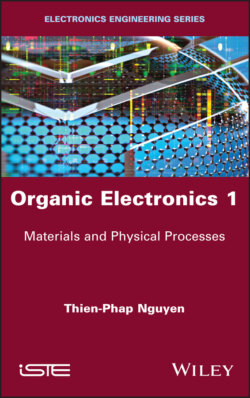Читать книгу Organic Electronics 1 - Thien-Phap Nguyen - Страница 5
Оглавление
Introduction
Organic electronics can be defined as a branch of general electronics that focuses on studying the properties and applications of organic semiconductors. These materials, referred to in common usage as plastics, are, in fact, a distinct class separate from that of ordinary plastic materials. They may be small molecules, or conjugated polymers, which have an electronic structure comparable to that of conventional semiconductors. Therefore, their physical properties are very similar to the properties of these latter materials. However, organic materials are generally amorphous and their electrical conductivity is much lower than that of traditional semiconductors. As a result, they have been neglected for a long time despite the discovery of some of their notable physical properties, such as the discovery of electroluminescence in anthracene in the 1960s.
In all scientific or technological disciplines, an idea, concept or creation can arise with a change or progression and profoundly alter the course of the evolution of the discipline – and sometimes even the course of the history of science. Such was the case in 1947 when the researchers John Bardeen, William Shockley and Walter Brattain invented the transistor, a device that would revolutionize traditional electronics. This invention is what first allowed for the design of circuits that provided logical functions, then for these circuits to be integrated into complex systems capable of handling sophisticated tasks, and finally for these miniaturized systems to be incorporated into the portable electronic devices that we now use every day. A similar progression occurred in organic electronics in 1987, when Tang and Van Slyke used the evaporation of small molecules in a vacuum to create diodes that emitted light in the form of a thin film that operated with a turn-on voltage lower than 10 V. Their work demonstrated that, in practice, organic devices are suitable for optoelectronic applications in the same way as their inorganic counterparts. A few years later, Burroughs et al. (1994) demonstrated that by using conjugated polymers deposited as thin films from a solution, they could also produce light-emitting diodes with a low operating voltage. This work paved the way for film depositing techniques using solutions and led to the production of devices through printing developed later in laboratories. For this domain, we will use the descriptors “flexible” or “printed” to indicate the discipline of organic electronics. Advances in research have been very rapid and have shown remarkable results, not only in the understanding of physical processes in materials and components but also for the creation of new electronic devices now available on the market. Today, organic electronics has become its own field, one that will prove to be important technologically and economically in the near future.
In France, education on organic electronics at the university level is developing, but remains limited in comparison with other European countries. It should be noted that these courses are generally offered in universities that carry out industrial research and development activities on organic electronic materials and devices. With regard to the books written on this discipline, there are very few titles available in French.
This book, divided into two volumes, was written with the goal of introducing organic electronics to students and researchers who are interested in this new discipline. It is organized into the following sections: Chapter 1 of Volume 1 provides an overview of the basic notions of the theory of traditional semiconductors, of which some of the material presented will be used later on. The materials used for the creation of devices are described in Chapter 2. The physical processes, which take place in the volume and interface of the layers of devices, are presented and explained in Chapters 3, 4 and 5. Volume 2 presents the primary applications of organic materials in optoelectronic devices. The first chapter of this volume centers on organic light-emitting diodes (OLEDs), the second on organic solar cells (OSCs or OPVs) and the third on organic field-effect transistors (OFETs). Chapter 4 deals with the practical and economic aspects of the industrialization of organic components. It also includes a discussion on the environmental aspects of the use of organic materials and devices.
As the title indicates, this book is not intended to provide a detailed and complete description of the materials, physical processes and applications involved in organic electronics. This would be far beyond the scope of what can be addressed within a single book. The choice of topics and of the extent to which the subjects are discussed were made by the author, based on his own experience from research and as an instructor. Interested readers will be able to find more detailed discussions on certain topics using the references provided. A list of acronyms used in the text is also included at the end of this book.
I would like to thank the people who devoted their time to proofreading and providing comments and suggestions, which allowed me to improve the writing of this book and the way in which certain areas are presented: Philippe Lerendu, Serge Lefrant, René Leparoux, Agnès Bournigal-Giret, Maxime Bayle and Jean-Luc Duvail. I would also like to thank ISTE for proposing this project, which I hope will help to arouse public interest in the new and promising possibilities offered by organic electronics in the scientific and technological communities in France and around the world.
